Introduction
This document describes Presence Reporting Area (PRA) based Differential National Security Agency (NSA) online Charging Solution.
Prerequisites
Requirements
Cisco recommends that you have knowledge of these topics:
- PRA
- Mobility Management Entity (MME)
- Cisco Serving Gateway (SGW)/ Cisco Packet Data Network Gateway (PGW)
- Policy and Charging Rules Function (PCRF)
Also,
- MME to support PRA feature enhancement to map “S1-U IP Address” to “PRA ID”
- PGW supports PRA Trigger towards PCRF
- PCRF installs new pcc rulebase once it receives the presence-reporting-area-status as In area (0) or out of area (1) from GW
Components Used
The information in this document is based on StarOS : 21.28.mx.
The information in this document was created from the devices in a specific lab environment. All of the devices used in this document started with a cleared (default) configuration. If your network is live, ensure that you understand the potential impact of any command.
Background Information
This feature is to support the requirement of differentiate the charging between 4G and 5G customers in the 5G NSA setup for Prepaid subscriber (online charging).
PRA is an area defined within 3GPP packet domain for reporting UE presence within that area for policy control and/or charging reasons.
For NSA Differential chanrging, PRA feature is used to report subscriber presence in 4G and 5G.
PRA ID Solution Overview
Expectation from/on MME:
- MME is expected to detect the UE movement from 4G to 5G coverage (gNB) and vice versa to build the logic to map this event with PRA reporting.
- PRA ID should be same as configured in PCRF for differential charging.
- Applicable to DCNR UE only.
PCRF subscribes to PRA Event trigger,
- PGW stores PRA action and forwards to SGW
When 4G to 5G transition happens (S1 tunnel switch):
- Based on gNB Transport Address, MME marks the PRA ID status as OPRA (out of 5G coverage)/IPRA (in 5G coverage)
- MME communicates PRA Information to SGW and SGW forwards to PGW
PGW receives PRA Information from SGW and forwards to PCRF
- PCRF changes rulebase based on PRA Information
- User-plane is communicated about change of rulebase
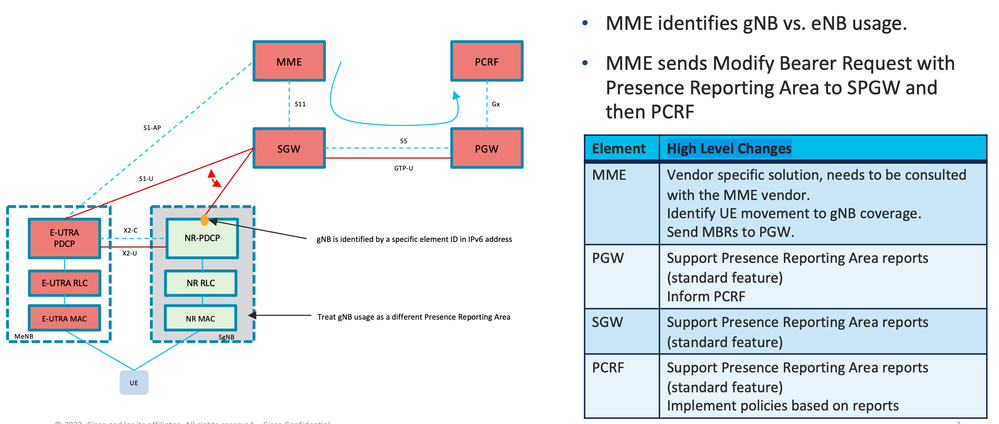 High level setup architecture
High level setup architecture
Abbreviations
|
PRA
|
Presence Reporting Area
|
|
OCS
|
Online Charging System
|
|
GW
|
Gateway (GGSN/PGW)
|
|
PCRF
|
Policy and Charging Rules Function
|
|
MOP
|
Method of Procedure
|
|
MME
|
Mobility Management Entity
|
|
SGW
|
Serving Gateway
|
|
PGW
|
Packet Gateway
|
Possible Impacts and Considerations
- Solution proposed for Option3x mode of 5G NSA Deployment only.
- Since UE Movement is tracked from 4G to 5G and 5G to 4G, this tracking is inform to SGW/PGW, so high number CCR-U’s are expected.
- Proposed solution is a customization and has not been implemented globally.
- End-to-end field testing required to be done in VI network
- CUPS UP/legacy SPGW Performance Impact due to extra signalling :
- Throughput Impact (extra signalling on SPGW + increased Sx modifications in CUPS solution)
- Frequent toggling of UE between 4G/5G will result in more signalling for PRA
- Slowpath/Fastpath flow switches due to Rulebase changes
- Cisco PCRF supports PRA feature
- Enabling differential charging will cause additional signaling on Gx interface, which can impact PCRF performance.
Flow
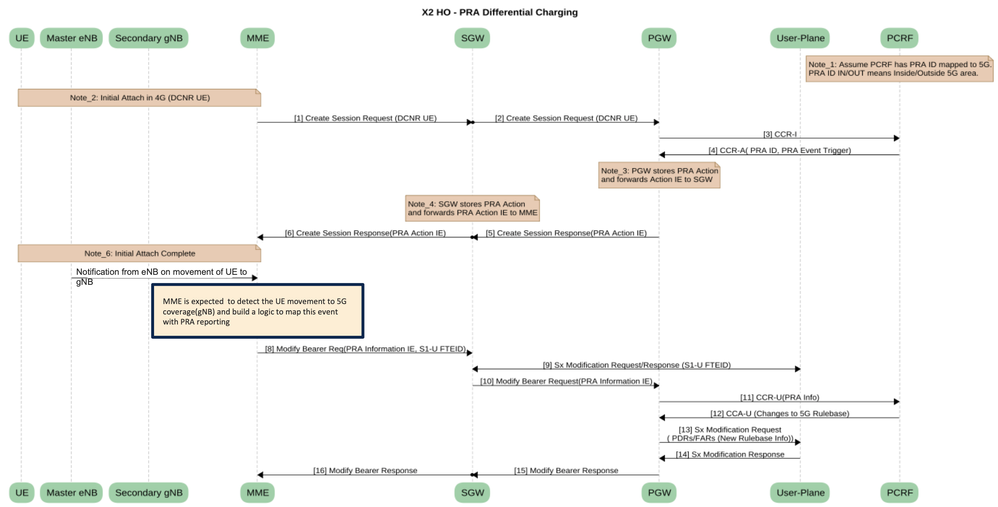 X2-HO – PRA Differential Charging
X2-HO – PRA Differential Charging
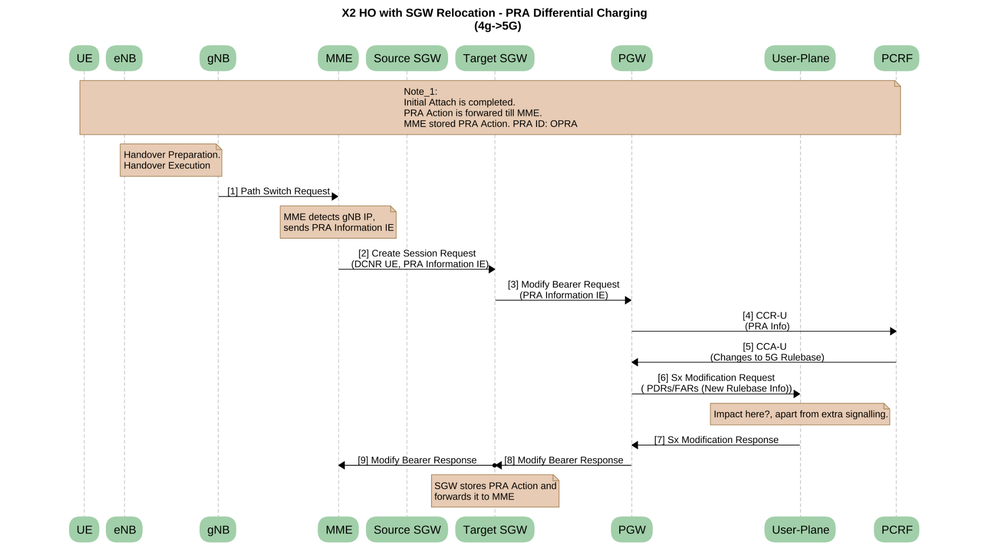 X2 HO with SGW Relocation - PRA Differential Charging (4g5g)
X2 HO with SGW Relocation - PRA Differential Charging (4g5g)
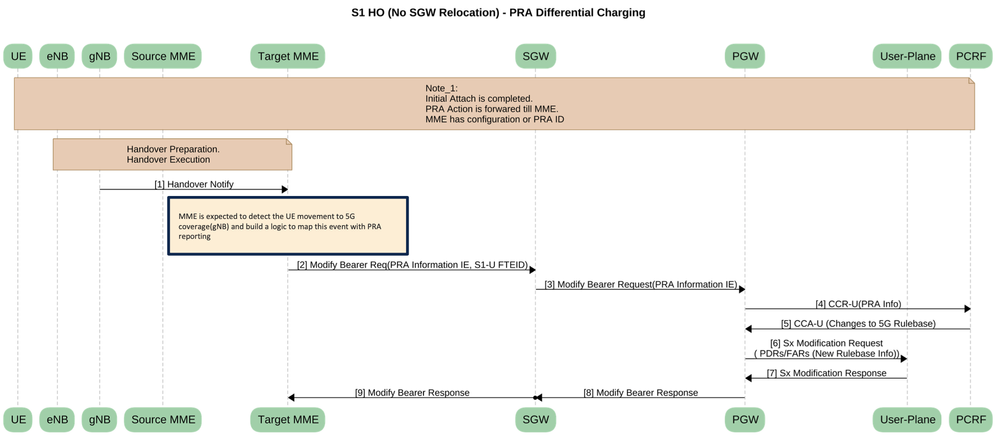 S1 HO (No SGW Relocation) - PRA Differential Charging
S1 HO (No SGW Relocation) - PRA Differential Charging
 GnGp (GGSN to PGW) HO – PRA Differential Charging (UE Moving to 5g)
GnGp (GGSN to PGW) HO – PRA Differential Charging (UE Moving to 5g)
Procedure
MME End Configuration Changes
- Configure pra-profile and associate pra-profile in mme-service.
- Up to 50 IPv4 subnets and 50 IPv6 subnets can be added to pra-profile.
As of now only pra-profile supported.
- At any point of time association or dissocation of pra-profile from mme-service doesn't give restart to mme-service.
config
lte-policy
pra-profile dcnr-5g-radio 5G-PRA
gnb-s1u ipv6-prefix 2401:4900:4:84a4::/64
gnb-s1u ipv6-prefix 2401:4900:2b::/48
gnb-s1u ipv6-prefix 2401:4900:4:8601::2:540d
exit
end
config
context s1mme
mme-service mme
associate pra-profile dcnr-5g-radio 5G-PRA
end
GW Configuration Changes
- Configure endcode-supported-feature cno-uli under ims-auth-service.
- cno-uli Enables Presence Reporting Area Information Reporting Feature.
- Configure separate RG. RG will be used to report 5G usage.
configure
context context_name
ims-auth-service service_name
policy-control
diameter encode-supported-features cno-uli
{ default | no } diameter encode-supported-features
end
config
active-charging service ECS
group-of-ruledefs NPR1_5G
group-of-ruledefs-application gx-alias
add-ruledef priority 2 ruledef RG_5G_default_IP_ANY_PrePaid
add-ruledef priority 40 ruledef tethering_ip_ttl_RG
exit
ruledef RG_5G_default_IP_ANY_PrePaid
ip any-match = TRUE
exit
rulebase <rulbase Name>
action priority 702 static-and-dynamic ruledef RG_5G_default_IP_ANY_PrePaid charging-action 5G_IP_ANY_with_Gy_PrePaid
exit
end
Notes:
-
diameter encode-supported-features : Enables or disables encoding and sending of Supported-Features AVP.
-
cno-uli : Enables Presence Reporting Area Information Reporting feature.
-
no : Removes the previously configured supported features.
-
default: Applies the default setting for this command.
Verification
Wireshark Capture MME
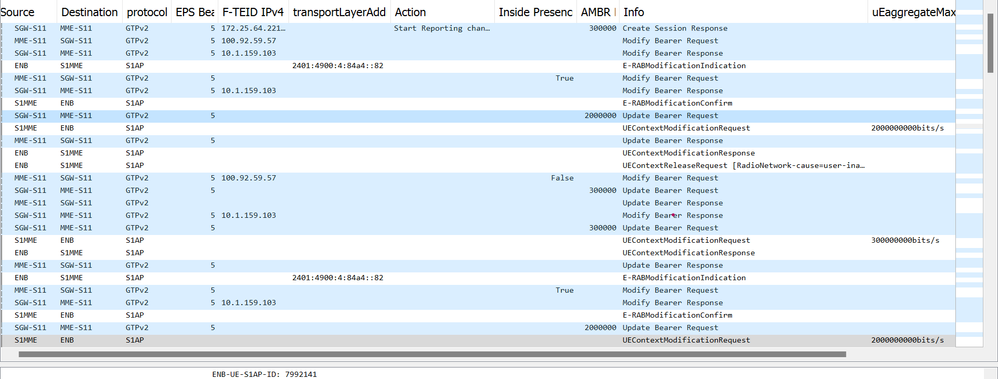
When UE moves to 5G, Inside Presence Reporting shows as True .
When UE moves to 4G, Inside Presence Reporting showing as False .
Wireshark Capture GW
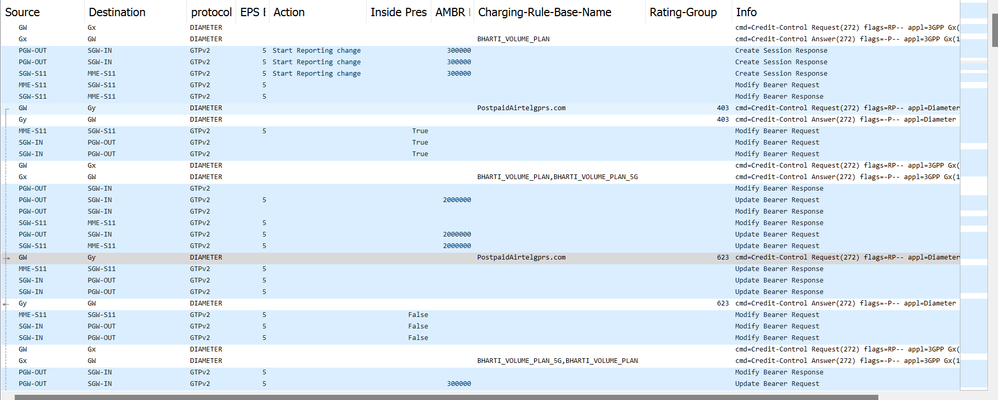
You can see when UE Moves to 5G Area Usage reported with RG: 623 while for 4G Usage reported with RG: 403.
DRA will receive presence-reporting-area-status as In area (0) when UE in 5G or out of area (1) when UE in 4G from GW,
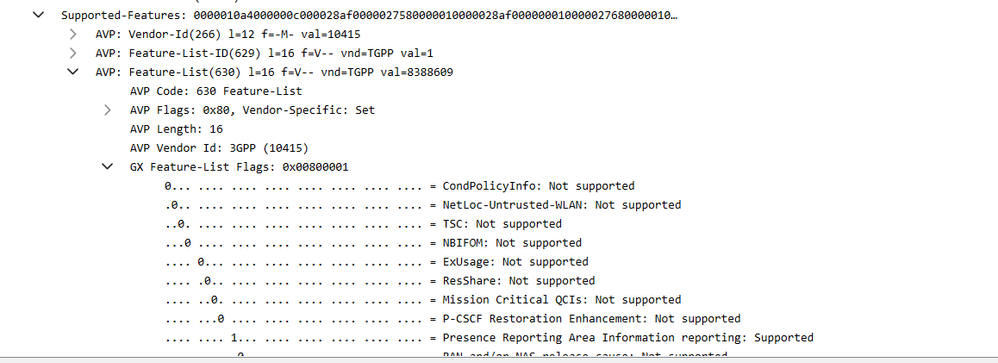 CCR-I
CCR-I
When MME reports presence reporting area true, GW sends CCR-I to PCRF with Presence Reporting Area Information : Supported.
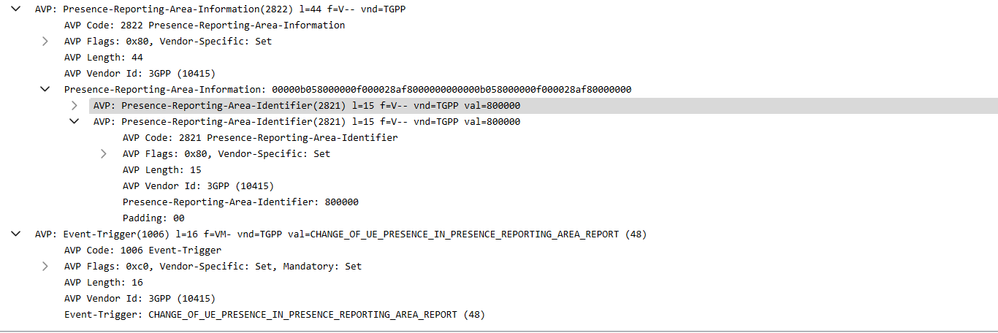 CCA-I
CCA-I
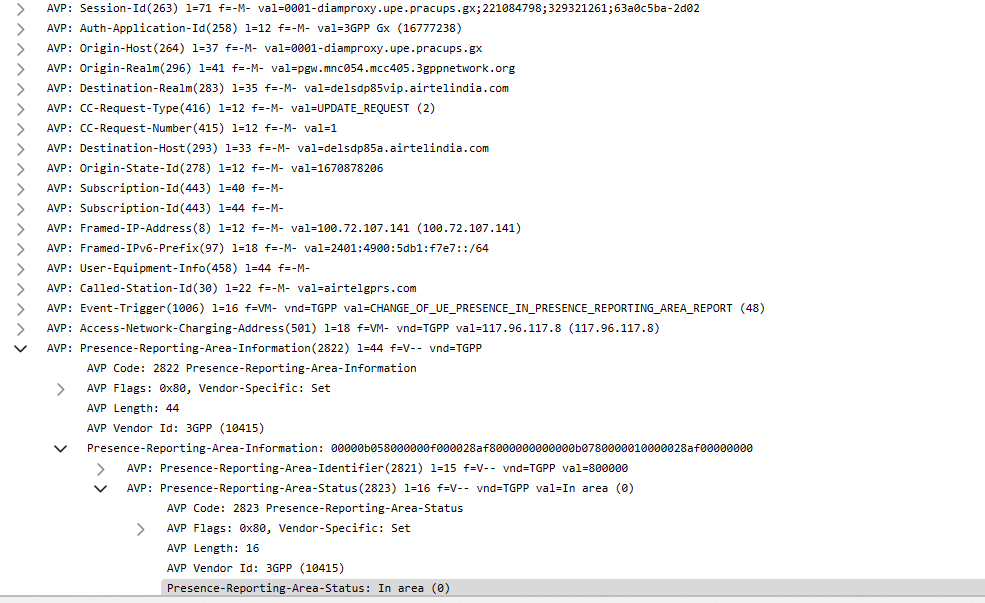 CCR-U
CCR-U
 GW - DRA - PCRF
GW - DRA - PCRF
Here, you can see that whenever DRA receives presence-reporting-area-status as In area (0) or out of area (1) from GW, it’s sending rat type as a GAN and EUTRAN respectively towards PCRF. Basis on this rat type PCRF is changing rulebase and modifying QOS for 4G and 5G.












 Feedback
Feedback